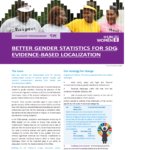Better Production and Use of Gender Statistics for Evidence-Based Localization of the SDGs (brief) is one of UN Women’s Flagship Programming Initiatives designed to ensure that UN Women can deliver on the SDGs. This Programme will support governments to improve the production of gender statistics to monitor SDGs, inform policy and ensure accountability. Data and statistics >> Read more
Brief: Gender and Food Security – Towards gender-just food and nutrition security
This BRIDGE Cutting Edge Overview Report makes the case for a new, gender-aware understanding of food security, arguing that partial, apolitical and gender-blind diagnoses of the problem of food and nutrition insecurity is leading to insufficient policy responses and the failure to realise the right to food for all people. Showcasing effective and promising existing >> Read more
Gender-Based Policies and Economic Growth
The World Bank’s policy note series Economic Premise recently put out a note on “Measuring the Effect of Gender-Based Policies on Economic Growth”. The note lays out a framework for quantifying the growth effects of gender-based policies in developing economies, a powerful and practical tool for policy makers and policy researchers. This tool was developed >> Read more
IFPRI Brief: the Gender Implications of Large Scale Land Deals
Whether viewed as “land grabs” or as agricultural investment for development, large-scale land deals by investors in developing countries are generating considerable attention. However, investors, policymakers, officials, and other key stakeholders have paid little attention to a dimension of these deals essential to truly understanding their impact: gender. It is easy to laud outside investment >> Read more
Publication: IFPRI 2020 Brief on ‘Gender: A key dimension linking agricultural programs to improved nutrition and health’
Improving the livelihoods and well-being of the rural poor is an important aim of agricultural development, promoted through agricultural intensification and commercialization strategies. But improved agricultural productivity does not necessarily translate into improved health and nutrition, either for producers or consumers. How can standard agricultural development strategies—promoting agricultural intensification, greater linkages to markets, and high-value >> Read more
Resource: Platform Policy Brief on Gender & Agriculture
Access it here
Brief: Participatory Research and Gender Analysis,The Work and Impact of a Systemwide Program
Available here
Brief: Rural women and agriculture in the MENA by CIHEAM
This briefing note will attempt to shed the light on some facts and figures related to the status of rural women in the MENA, all the while focusing on the main challenges to be taken into account in terms of rural women's entitlements in the MENA. These key features can then help delineate where the >> Read more
Resource: GENDER EQUALITY INDICATORS Brief WHAT, WHY AND HOW?
This OECD practice note focuses on the use of gender equality indicators as a way of measuring change. It asks: what are indicators, and why should we develop indicators to measure gender equality? It also addresses the often political issue of what we should be measuring, provides some broad principles that can be applied, and >> Read more
CPRC Brief: ‘Curbing dowry practices: an anti-poverty imperative’
Peter Davis Kathryn Bach Abstract It has been recognised that dowry in South Asia hinders women’s empowerment and can serve as a cause of violence against women. A recent study in Bangladesh highlights that dowries also have serious economic repercussions, with families identifying dowry payment as a leading cause of impoverishment. This policy brief also >> Read more

